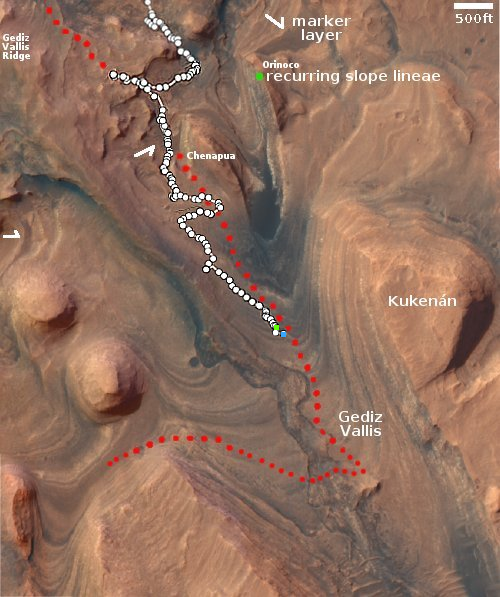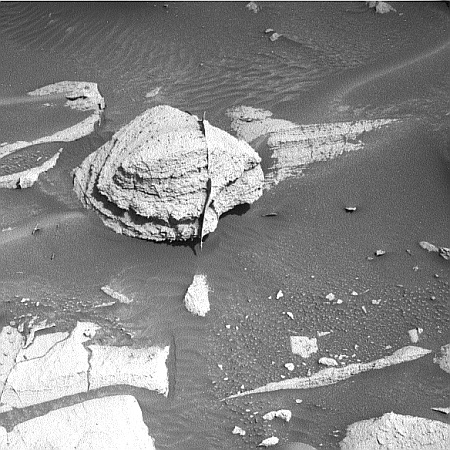A rock tadpole on Mars
Cool image time! The picture to the right, cropped, reduced, and sharpened to post here, was taken on January 11, 2024 by the left navigation camera of the Mars rover Curiosity.
The picture was highlighted in yesterday’s update from the rover’s science team, describing the team’s upcoming geological goals for the next few days.
We have observed resistant, polygonal fractures/ridges in many recent bedrock blocks. There is much speculation among the team as to the origin of these features. Hypotheses have different implications for past environments, and the polygonal fractures are therefore of high interest. As well as the polygonal fractures, there are more continuous linear veins. The relationship between the polygonal and linear fractures can also help to inform our interpretations
You can see the polygonal fractures in the full image. The thin line of rock sticking up from the tadpole illustrates one of these continuous linear veins. The material that fills the vein is obviously more resistent to erosion, so as the wind (and maybe ancient ice or water activity) scoured the rock into its tadpole shape, the vein material remained.


Click for interactive map.
Curiosity continues its slow ascent up into Gediz Vallis. The green dot marks its location about three weeks ago. The blue dot marks its present position. Not only does the ground continue to be very rocky, slowing travel, the scientists are in no rush, because every few feet they travel into a new layer of material, and wish to see how each layer differs.
To understand this, look at the western cliff face of the mountain Kukenan. If you trace the many layers on that cliff face back to Curiosity, you can see that with every step the rover is essentially climbing that cliff face, geologically. As it moves up Gediz Vallis along its planned route (as indicated by the red dotted line), it crosses from one layer to the next. Each time the scientists want to take another close look, because each layer marks a different geological epoch, with its own history.
Curiosity will actually cross halfway up the face of Kukenan, geologically if not in reality, before it turns to the west to find a workable route higher up Mount Sharp.
On Christmas Eve 1968 three Americans became the first humans to visit another world. What they did to celebrate was unexpected and profound, and will be remembered throughout all human history. Genesis: the Story of Apollo 8, Robert Zimmerman's classic history of humanity's first journey to another world, tells that story, and it is now available as both an ebook and an audiobook, both with a foreword by Valerie Anders and a new introduction by Robert Zimmerman.
The print edition can be purchased at Amazon or from any other book seller. If you want an autographed copy the price is $60 for the hardback and $45 for the paperback, plus $8 shipping for each. Go here for purchasing details. The ebook is available everywhere for $5.99 (before discount) at amazon, or direct from my ebook publisher, ebookit. If you buy it from ebookit you don't support the big tech companies and the author gets a bigger cut much sooner.
The audiobook is also available at all these vendors, and is also free with a 30-day trial membership to Audible.
"Not simply about one mission, [Genesis] is also the history of America's quest for the moon... Zimmerman has done a masterful job of tying disparate events together into a solid account of one of America's greatest human triumphs."--San Antonio Express-News
Cool image time! The picture to the right, cropped, reduced, and sharpened to post here, was taken on January 11, 2024 by the left navigation camera of the Mars rover Curiosity.
The picture was highlighted in yesterday’s update from the rover’s science team, describing the team’s upcoming geological goals for the next few days.
We have observed resistant, polygonal fractures/ridges in many recent bedrock blocks. There is much speculation among the team as to the origin of these features. Hypotheses have different implications for past environments, and the polygonal fractures are therefore of high interest. As well as the polygonal fractures, there are more continuous linear veins. The relationship between the polygonal and linear fractures can also help to inform our interpretations
You can see the polygonal fractures in the full image. The thin line of rock sticking up from the tadpole illustrates one of these continuous linear veins. The material that fills the vein is obviously more resistent to erosion, so as the wind (and maybe ancient ice or water activity) scoured the rock into its tadpole shape, the vein material remained.

Click for interactive map.
Curiosity continues its slow ascent up into Gediz Vallis. The green dot marks its location about three weeks ago. The blue dot marks its present position. Not only does the ground continue to be very rocky, slowing travel, the scientists are in no rush, because every few feet they travel into a new layer of material, and wish to see how each layer differs.
To understand this, look at the western cliff face of the mountain Kukenan. If you trace the many layers on that cliff face back to Curiosity, you can see that with every step the rover is essentially climbing that cliff face, geologically. As it moves up Gediz Vallis along its planned route (as indicated by the red dotted line), it crosses from one layer to the next. Each time the scientists want to take another close look, because each layer marks a different geological epoch, with its own history.
Curiosity will actually cross halfway up the face of Kukenan, geologically if not in reality, before it turns to the west to find a workable route higher up Mount Sharp.
On Christmas Eve 1968 three Americans became the first humans to visit another world. What they did to celebrate was unexpected and profound, and will be remembered throughout all human history. Genesis: the Story of Apollo 8, Robert Zimmerman's classic history of humanity's first journey to another world, tells that story, and it is now available as both an ebook and an audiobook, both with a foreword by Valerie Anders and a new introduction by Robert Zimmerman.
The print edition can be purchased at Amazon or from any other book seller. If you want an autographed copy the price is $60 for the hardback and $45 for the paperback, plus $8 shipping for each. Go here for purchasing details. The ebook is available everywhere for $5.99 (before discount) at amazon, or direct from my ebook publisher, ebookit. If you buy it from ebookit you don't support the big tech companies and the author gets a bigger cut much sooner.
The audiobook is also available at all these vendors, and is also free with a 30-day trial membership to Audible.
"Not simply about one mission, [Genesis] is also the history of America's quest for the moon... Zimmerman has done a masterful job of tying disparate events together into a solid account of one of America's greatest human triumphs."--San Antonio Express-News



I think if you blow off some of the dust, you will see NCC 1701 in large print on the side…..
Well, thats what it looks like to me, a crashed starship.
Jhon B: My gosh, you’re right! I hadn’t noticed the resemblance to the Enterprise until you mentioned it!
Surely there is a rock lobster nearby.